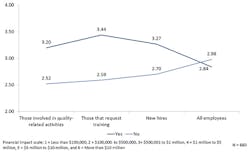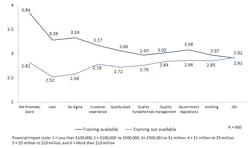In 2016, ASQ and APQC partnered to conduct a survey that would provide a comprehensive look at intercontinental quality and continuous improvement methodologies and to explore organizational practices used for quality governance, management and measurement.
This four-part series looks at what helps drive financial benefits from quality, including looking at the relationship between financial benefits and:
- the role and uses of quality,
- governance and standardization of quality,
- quality training for suppliers, and
- quality incentives and training for staff.
In part three of this series we expanded the discussion on the benefits of transparency and cross-functional integration with external partners, namely suppliers. What we found was that organizations that establish training for their suppliers tend to reap higher financial benefits from quality efforts. Training provides a common language and helps suppliers understand the impact that defects or other setbacks like delays will have on the end customer, ultimately resulting in a unified focus on the customer and increased financial benefits.
The same ideas of transparency, common language, and understanding the impact of role on quality should also hold true for the organization’s employees. Hence in this final article, we will look more closely at the relationship between employee training and incentives.
Training Employees and Financial Value
Training programs help develop competencies, ensure employees understand their role in creating quality for the customer, and establish a quality-focused culture. Hence respondents were asked to indicate if they had a formal quality-related training program. Though the majority of organizations do not have a formal training program, more organizations (43%) are investing in a training program than were in 2013 (32%).
Though it can be argued there is intrinsic financial value in offering quality training, there are still unanswered questions such as: Who should receive the training and what training should we provide?
Who Should Get Training?
The majority of respondent organizations (56%) offer (either through direct training or compensation for external training) quality management training for staff involved in quality actives. Almost half of the respondent organizations (44%) also offer quality-related training to all employees, likely driven by the need to embed a quality-focused culture within the organization.
To understand where organizations should focus their training resources—in regards to ROI—we ran analysis against the employees offered training and the organizations’ financial benefits of quality (Figure 1).
Though the conventional wisdom would be to increase quality training to all employees to develop a shared perspective and bolster a culture of quality, the analysis indicates a drop-off in financial benefits for organizations that offer quality training to all employees. Instead the largest increase in financial benefits comes from providing training for quality-related staff and those who specifically request training.
What Training Topics Matter?
The majority of organizations focus their training on quality fundamentals, auditing, ISO, quality management principles and quality tools. However, few organizations include training on more customer-value concepts such as the customer experience, Net Promoter Score (NPS) and lean. To understand what training supports increased financial benefits from quality, we ran analysis against the type of training provided and the organizations’ financial benefits of quality (Figure 2).
What we found was that almost all of the types of training discussed in the survey correlated to improved financial benefits. However, organizations that provided training on customer-value related concepts like NPS, lean, Six Sigma and the customer experience were more likely to reap higher financial benefits. This makes sense given the relationship between customer value and financial benefits discussed in the first article. Organizations that use quality as a competitive differentiator -- for the benefit of the customer and enhance brand image -- reap higher financial benefits.
Role of Incentives
Similar to training, incentives help reinforce preferred behaviors—such as a quality focus. To understand the role that incentives play in quality respondents were asked, “What incentives, if any, do you use to encourage employees to meet critical quality targets?”
Given that most organizations do not include quality measure-based goals in their variable performance compensation, it makes sense that financial and variable compensation are not readily used incentives. Instead, organizations use informal recognition by management to encourage employees to meet quality targets. Though immediate recognition can help create buy-in on a person-by-person basis, using formal recognition and tying quality goals into performance can help generate a widespread cultural change faster. However we wanted to see if specific incentives also had a direct financial impact (Figure 3).
What we found was that all types of incentives increase the financial benefits of quality. However informal manager recognition -- followed by honorary awards -- has the greatest impact on financial benefits. This does not mean organizations should not still consider financial incentives such as tying quality measures to performance goals. As noted earlier, awards and informal recognition are excellent tools for engagement and ongoing motivation, but financial measures tend to increase cultural changes in the long run.
Conclusion
Best-in-class organizations use training to drive a commitment to quality and help employees understand their role in quality -- including their impact on the end customer and driving value. However, organizations need to consider the purpose of their quality efforts before making decisions on incentives, the types of training, and even which employees to target for training. If the organization’s goals are to create a widespread culture of quality, then casting a wide net for measures tied to quality and training all employees on the fundamentals of quality and impact on the customer could reap the most benefits. However if the organization is specifically leveraging quality to provide customer value -- and potential price premiums -- then it should consider incorporating training aimed at the customer experience and related concepts such as lean and NPS.
Holly Lyke-Ho-Gland is process and performance principal research lead with APQC, a member-based nonprofit and one of the leading proponents of benchmarking and best practice business research.







